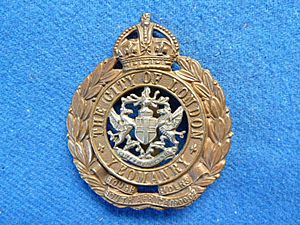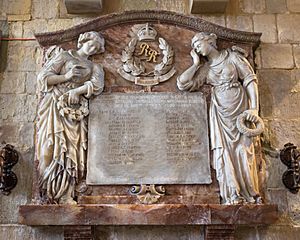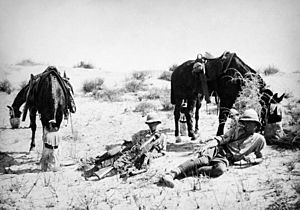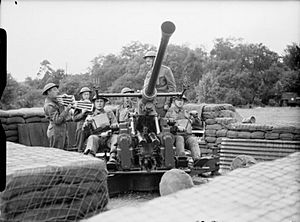City of London Yeomanry (Rough Riders) facts for kids
Quick facts for kids The City of London Yeomanry (Rough Riders) |
|
|---|---|

CoLY Cap Badge
|
|
| Active | 23 July 1901 – 1 May 1961 |
| Country | |
| Branch | |
| Type | Yeomanry |
| Role | Cavalry (1901) Field artillery (1920) Light Anti-Aircraft artillery (1938) Armour (1947) Infantry (1956) Signals (1969) |
| Size | Regiment |
| Garrison/HQ | 39 Finsbury Square 130 Bunhill Row |
| Nickname(s) | The Roughs |
| Patron | Her Majesty Queen Elizabeth The Queen Mother (1952) |
| Motto(s) | Domine Dirige Nos (Lord, direct us) |
| Mascot(s) | The Lobster |
| Engagements | Second Boer War First World War
|
| Commanders | |
| Notable commanders |
Richard Colvin Frederick Maitland, 14th Earl of Lauderdale Goland Clarke |
The City of London Yeomanry (Rough Riders) was a special army unit in the United Kingdom. It was part of the Territorial Army, which was a group of volunteer soldiers. The unit started in 1901. Many of its first members were soldiers who had fought in the Second Boer War.
Over the years, the Rough Riders changed their role many times. They started as horseback soldiers. Later, they became artillery (using big guns) and then anti-aircraft (shooting down enemy planes). They even became tank crews and foot soldiers. In 1961, they joined with another unit called the Inns of Court Regiment. Today, their history is carried on by a modern signals squadron.
Contents
Imperial Yeomanry: The Beginning

In 1899, Britain was fighting the Second Boer War in South Africa. The regular army needed more soldiers. So, the government decided to let volunteers join a new force called the Imperial Yeomanry (IY). These volunteers were often from wealthy families. They were trained to fight on horseback.
The 20th (Rough Riders) Battalion, IY, was formed in London in March 1900. Its name came from Theodore Roosevelt's famous "Rough Riders" in America. This battalion had four companies of soldiers. They were led by Lieutenant-Colonel Richard Colvin. They trained for only one month before sailing to South Africa in April 1900.
Once in South Africa, the Rough Riders' companies joined different army groups. They fought in various battles against the Boers. The Rough Riders were popular because they received lots of food and comforts from their families back home. During the war, the 20th Battalion lost 30 men. Many others were wounded.
After a year, many Rough Riders signed up for a second term. In March 1901, a new unit, the 22nd (Rough Riders) Battalion, IY, was formed. This new battalion also sailed to South Africa. Both Rough Rider battalions were disbanded when the war ended in 1902.
The Imperial Yeomanry was a success. So, in July 1901, the Rough Riders became a permanent unit. They were named the 1st County of London Imperial Yeomanry (Rough Riders). Their headquarters was in Finsbury Square in London. In 1902, their name changed to City of London Imperial Yeomanry (Rough Riders). They were given the special honour "South Africa 1900–02" for their service.
Territorial Force: A New Era
In 1908, the British army changed its structure. The Imperial Yeomanry became part of the new Territorial Force (TF). The Rough Riders dropped "Imperial" from their name. They became part of the London Mounted Brigade, a group of cavalry units in London.
First World War: Fighting Around the World
Mobilisation for War
When the First World War began in August 1914, the Rough Riders got ready for action. Most soldiers volunteered to serve overseas. So, the unit was split into different groups:
- 1st Line units: These went to fight abroad.
- 2nd Line units: These were reserve units for training new recruits.
- 3rd Line units: These provided trained replacements for the other lines.
1/1st City of London Yeomanry: Overseas Service
The 1st Line regiment trained in England. In March 1915, they prepared to go overseas.
Gallipoli Campaign
In April 1915, the Rough Riders sailed to the Mediterranean Sea. They arrived near Cape Helles during the Gallipoli Campaign. This was a tough fight against the Ottoman (Turkish) army. The Rough Riders were ordered to fight on foot, leaving their horses behind in Egypt.
On August 18, they landed at Suvla Bay. They took part in a fierce attack on Hill 112. The soldiers faced heavy fire and suffered many casualties. The Rough Riders reached Green Hill, finding it full of dead and wounded soldiers. They had to retreat that night. Because of their losses, the unit had to be reorganized. The remaining Rough Riders combined with other units to form the "4th London Regiment." They continued to fight in the trenches until November, when they returned to Egypt.
Fighting in Egypt
Back in Egypt, the Rough Riders fought in the Senussi campaign in December 1915. They took part in a surprise night attack on the Senussi forces. In 1916, they helped defend the Suez Canal. They also took part in a raid into the Sinai Desert against a Turkish post.
To Salonika and Palestine
In November 1916, the regiment moved to the Macedonian front near Salonika. This front was mostly quiet. In June 1917, the Rough Riders returned to Egypt and then moved to Palestine. They joined the Yeomanry Mounted Division.
Battles in Palestine
The British army was preparing for a big attack at Gaza. In October 1917, the Rough Riders helped defend an outpost line. One of their squadrons, led by Major L.P. Stedall, bravely rode to support another unit under heavy fire. Major Stedall was wounded twice but still led his men. He later received the Distinguished Service Order (DSO) for his bravery.
The Rough Riders also took part in the Battle of Beersheba and the advance towards Jerusalem. They faced tough terrain and strong Turkish resistance in the Judaean Hills. In November, they fought in the Battle of Nebi Samwil, holding their ground against Turkish counter-attacks. The soldiers suffered greatly from the cold winter weather.
In March 1918, many British units from Palestine were sent to the Western Front in France. The Rough Riders and another unit, the Sharpshooters, were combined to form E Battalion of the Machine Gun Corps.
On the Western Front
E Battalion arrived in France in June 1918. In August, it was renamed 103rd (City & 3rd County of London Yeomanry) Battalion, MGC. The battalion stayed on the Western Front until the war ended in November 1918. They were disbanded in 1919.
2nd and 3rd Line Regiments
The 2nd Line regiment was formed in London in August 1914. It trained in England and later became a cyclist unit. The 3rd Line regiment was formed in 1915 to provide new soldiers. These units stayed in the UK throughout the war.
Between the Wars: New Roles
After the war, most cavalry units were changed to other roles. In 1920, the Rough Riders became part of the Royal Artillery (RA). They joined the Honourable Artillery Company (HAC) to form a battery (a group of artillery guns). Their headquarters was at 39 Finsbury Square.
By the mid-1930s, the army needed more anti-aircraft (AA) units to defend against planes. In 1938, the Rough Riders battery was expanded to become a full anti-aircraft regiment. It was named 11th (City of London Yeomanry) (Rough Riders) LAA Brigade, RA. They were armed with Bofors 40 mm guns. In 1939, it was renamed 11th (City of London Yeomanry) (Rough Riders) LAA Regiment, RA.
Second World War: Defending Britain and Beyond
Getting Ready for War
In September 1938, the anti-aircraft units were called up during a crisis. They quickly set up their guns to defend important places. When war was declared in September 1939, the 11th (CoLY) LAA Regiment moved to defend key locations around London. These included airfields, power stations, and docks. They were part of the 56th Light Anti-Aircraft Brigade.
During this time, the army was short on equipment. The Rough Riders used older guns and even Lewis guns to defend their positions.
Battle of Britain and The Blitz
In May 1940, the regiment's guns were spread out to defend RAF Fighter Command airfields. These airfields were constantly attacked during the Battle of Britain. For example, a troop of the 31 LAA Battery shot down two German bombers at RAF Kenley in August.
After the Battle of Britain, the German air force started bombing London at night. This was called The Blitz. The Rough Riders' role changed to defending factories and other important sites around London. They continued to train new recruits.
Fighting in North Africa and Italy
In November 1942, the regiment finally sailed to North Africa as part of the First Army. They arrived in Tunisia and defended important army locations from German and Italian dive-bombing attacks. The British anti-aircraft guns forced enemy planes to fly higher. By May 1943, the entire regiment was protecting airfields.
The 11th (CoLY) LAA Regiment then joined the Italian Campaign. They mainly defended airfields and gun areas. By late 1944, the German air force was much weaker. The British army also needed more soldiers for fighting on the ground. So, some anti-aircraft units, including the Rough Riders, were retrained to fight as foot soldiers for defense duties. They used mortars and heavy machine guns to support other troops.
In March 1945, the regiment supported the British army's final push in Italy. They helped chase the retreating German forces. Their last anti-aircraft action was on April 20, 1945. After the war ended in May, the regiment helped with transport duties.
1 (City of London Yeomanry) Airlanding LAA Battery
A special battery, 283 LAA Battery, was formed in 1941. It later became 1st (City of London Yeomanry) Air Landing LAA Battery and joined the 1st Airborne Division. This meant they were trained to be flown into battle by gliders.
In July 1943, the battery was part of the Allied invasion of Sicily (Operation Husky). However, they did not fly in with the gliders. The division was later sent to Italy in September 1943. They helped capture ports and airfields. In February 1944, the battery left the airborne division and went back to its old name, 283 LAA Battery.
After the War: Changes and Legacy
After the Second World War, the Rough Riders continued to change. In 1947, the City of London Yeomanry (Rough Riders) was reformed as an armoured regiment (using tanks). They were part of the 56th (London) Armoured Division.
In 1956, the division changed back to an infantry (foot soldier) unit. The Rough Riders also became an infantry battalion.
On May 1, 1961, the Rough Riders joined with the Inns of Court Regiment. They formed the Inns of Court & City Yeomanry. Later, in 1967, this unit became a signals squadron. Today, the history of the City of London Yeomanry (Rough Riders) is kept alive by the 68 (Inns of Court & City Yeomanry) Signal Squadron.
Uniforms and Badges
The early Rough Riders wore khaki uniforms and slouch hats. Their special uniform was blue-grey with purple details. Their cap badge showed the Coat of arms of the City of London. Their collar badge was a spur with the letters "R.R." for Rough Riders.
During the Second World War, the 11th (CoLY) LAA Regiment used the spur and "R.R." as their cap badge. They also wore a purple shoulder patch with "ROUGH RIDERS" written in white.
After the Second World War, the regiment received a special honour for their service in North Africa and Italy. This was a gun badge with "1942–45" and the names of the campaigns.
Important People
Many important people served with the Rough Riders. These included:
- Lieutenant-Colonel Viscount Maitland, an early commanding officer.
- The 5th Earl of Limerick, another commanding officer.
- Queen Elizabeth The Queen Mother, who became their Honorary Colonel in 1952.
- Cosmo Gordon Lang, who later became the Archbishop of Canterbury, served as their Chaplain.
- Several members of the Stedall family, who were famous ironmongers, served in the regiment. Major Leigh Pemberton Stedall won the DSO for bravery in Palestine. His nephew, Lieutenant-Colonel Marcus Bertram Pemberton Stedall, commanded the regiment during the early part of the Second World War.
- Famous cricketers like Gubby Allen also served in the regiment.
Memorials
There are several memorials to the Rough Riders:
- A white marble tablet in Waltham Abbey Church lists the names of the 30 men who died in the Second Boer War.
- The First World War memorial for the regiment is in St Bartholomew-the-Great Church in London. It lists 96 names, with eight more names added for the Second World War.
- The regiment is also listed on the London Troops War Memorial in front of the Royal Exchange.
Battle Honours
The City of London Yeomanry earned special "battle honours" for their bravery in different wars:
- Second Boer War
- First World War
Pursuit to Mons, France and Flanders 1918, Macedonia 1916–17, Suvla, Scimitar Hill, Gallipoli 1915, Rumani, Egypt 1915–16, Gaza, El Mughar, Nebi Samwil, Palestine 1917–18
- Second World War
The Royal Artillery does not have battle honours in the same way. Instead, units like the Rough Riders received a special honorary distinction for their service. This distinction was a gun badge with "1942–45" and the names "North Africa" and "Italy" on it.
Images for kids







